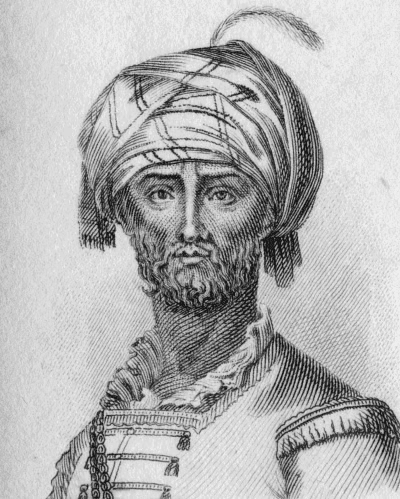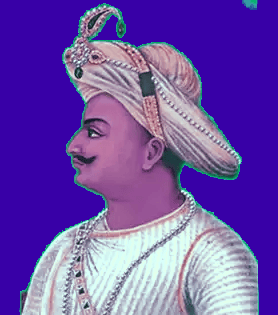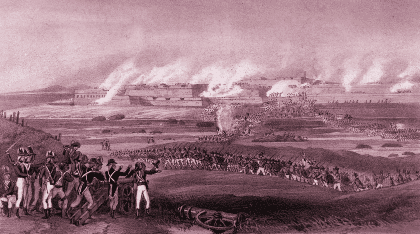British Expansion in India: Mysore | History Optional for UPSC PDF Download
Rise of Mysore Kingdom Post-Vijayanagara
- After the battle of Talikota (1565), the great kingdom of Vijayanagara was severely weakened, leading to the emergence of many small kingdoms from its remnants.
- In 1612, a Hindu kingdom under the Wodeyars dynasty was established in the region of Mysore.
- The Wodeyars' centralized military power began to strengthen in the late 17th century under Chikkadevaraja Wodeyar (1672-1704), but the kingdom reached its peak under Haidar Ali.
- In the early 18th century, two brothers, Nanjaraj (the sarvadhikari) and Devaraj (the Dulwai), effectively reduced Chikka Krishnaraja Wodeyar (1734-1766) to a puppet ruler.
- During the second half of the 18th century, Mysore emerged as a powerful force under the leadership of Haidar Ali and his son,Tipu Sultan.
Haidar Ali

- Haidar Ali, of humble beginnings, rose from a junior officer in the Mysore army to a prominent leader. Despite his lack of formal education, his sharp intellect, energy, and determination set him apart.
- In 1761, Haidar Ali seized political control in Mysore by removing the corrupt Nanjraj, who had diminished the Wodeyar king to a mere figurehead.
- Mysore faced financial and political weakness due to repeated invasions by the Marathas and the Nizam’s troops. The kingdom needed a strong military and diplomatic leader, which Haidar Ali became.
- Haidar Ali modernized the Mysore army with the help of French experts, who trained the troops in infantry, artillery, and European discipline.
- To counter the Marathas, he established a swift cavalry. He set up an arms factory at Dindigul(now in Tamil Nadu) with French assistance and introduced Western training methods.
- The army was organized on a European model, with a clear chain of command through risalas(units), each led by a commander appointed by Haidar Ali.
- He consolidated power by subjugating local chiefs and warriors. Despite defeats by the Marathas in 1764, 1766, and 1771, Haidar Ali eventually regained lost territories and expanded his domain.
- Haidar Ali and his son,Tipu Sultan, implemented a land tax system directly on peasants, enhancing state resources. This system involved detailed land surveys and classifications, with varying rent rates based on soil productivity.
- While it retained the Mughal jagir system, it limited its application to a small portion of land.
Tipu Sultan

Revenue System and Military Expansion:
- Tipu Sultan's revenue system was described by Burton Stein as "military fiscalism", where taxes were collected directly by state officials to fund a large army.
- This approach aimed to establish centralized military control by eliminating intermediaries who shared power during the Vijayanagara Empire.
Agricultural Development and Modernization:
- Tipu Sultan encouraged agricultural development through tax remission for wasteland reclamation and protected peasants from tax collectors.
- Even his enemies acknowledged that his territory had the best cultivation and the most flourishing population in India.
- He modernized the agricultural economy by repairing and constructing irrigation systems, promoting agricultural manufacturing, and introducing sericulture in Mysore.
Naval Expansion and Trade Initiatives:
- Tipu Sultan built a navy with the ambition of participating in oceanic trade, sending ambassadors to France for European technology.
- He launched a state commercial corporation in 1793, planning to establish factories outside Mysore.
- Mysore engaged in lucrative trade in valuable goods like sandalwood, rice, and silk, establishing trading centers in western India and overseas, such as Muscat.
- Conflict and Expansion
- Under Haidar Ali and Tipu Sultan, Mysore aimed for centralized military control, expanding its territory through conquests like Malabar and Calicut.
- Conflicts with neighboring powers like the Marathas, Hyderabad, and the English were frequent. Haidar Ali defeated the English near Madras in 1769.
- Tipu Sultan continued his father's policies until his defeat by the English in 1799, dying while defending his capital, Srirangapatnam.
Relations with the Mughal Empire:
- Tipu Sultan's reign marked a break from the Mughal influence in the 18th century, as he asserted regional authority by issuing coins without Mughal references and seeking legitimacy from the Ottoman Khalif.
- Despite this, he maintained a pragmatic relationship with the Mughal emperor, recognizing authority when beneficial and defying it when necessary.
Conflict with the British:
- The English perceived Mysore as a threat due to its proximity to the French, control over Malabar trade, and ambitious territorial expansion.
- Tipu Sultan's embargo on exports like pepper and sandalwood and his strong centralized state posed a danger to the English Company.
- The British, influenced by private merchants and military officers, decided to eliminate Mysore, culminating in the annexation of Dindigul, Baramahal, and Malabar.
- Tipu Sultan's secret negotiations with the French prompted Lord Wellesley to finalize colonial aggression against Mysore.
- Mysore was reestablished under the Wodeyar dynasty and subjected to the 'Subsidiary Alliance' system, ending its independence.
Anglo-Mysore Wars
First Anglo-Mysore War (1767-69)

Background:
- After their success in Bengal, the English felt confident in their military strength. In 1766, they made a treaty with the Nizam of Hyderabad, convincing him to give them the Northern Circars in exchange for protection against Haidar Ali.
- Haidar Ali was already in conflict with the Nawab of Arcot and had issues with the Marathas.
Changing Alliances:
- The Nizam, the Marathas, and the English formed an alliance against Haidar Ali.
- Haidar, however, used diplomacy effectively. He paid the Marathas to remain neutral and promised the Nizam shared conquests, turning the Nizam into his ally. He then joined forces with the Nizam to attack the Nawab of Arcot.
Course of War:
- The war dragged on for a year and a half without a clear outcome. Haidar changed tactics and suddenly appeared at the gates of Madras, causing panic and chaos. This forced the English to sign a humiliating treaty with Haidar on April 4, 1769, known as the Treaty of Madras.
- The treaty involved the exchange of prisoners and the mutual restitution of conquests. It also promised Haidar Ali English support in case he was attacked by any other power.
Second Anglo-Mysore War (1780-84)
Background:
- Haidar Ali accused the English of breaching the Treaty of Madras when they failed to assist him against the Marathas in 1771.
- He found the French more reliable than the English for military supplies. Through Mahe, a French possession, he imported French war materials.
- The French support during the American War of Independence heightened English concerns over Haidar Ali's alliance with the French.
- The English attempted to capture Mahe, which Haidar considered under his protection, escalating tensions.
Course of War:
- Haidar Ali formed an anti-English alliance with the Marathas and the Nizam.
- He attacked the Carnatic, capturing Arcot and defeating the English under Colonel Baillie in 1781.
- The English, led by Sir Eyre Coote, managed to detach the Marathas and the Nizam from Haidar's side.
- Despite facing setbacks, Haidar regrouped and achieved victories, including capturing English commander Braithwaite.
Treaty of Mangalore:
- Haidar Ali passed away on December 7, 1782.
- His son, Tipu Sultan, continued the war for a year without significant success.
- Frustrated with the stalemate, both sides agreed to the Treaty of Mangalore in March 1784, restoring territories taken by each side.
Third Anglo-Mysore War
Circumstances:
- Lord Cornwallis, the Governor General, exploited the suspicions of the Nizam and the Marathas against Tipu, forming a Triple Alliance in 1790.
- Tipu Sultan, anticipating war with the English, sought assistance from the Turks and the French through diplomatic missions.
- Tipu's ambitions to conquer Travancore led to tensions, especially after the Raja of Travancore angered Tipu by fortifying borders and purchasing forts from the Dutch East India Company.
- Tipu's attack on Travancore in April 1790 prompted the English to side with Travancore, marking the beginning of the Third Anglo-Mysore War.
Course of War:
- The English, allied with Travancore, launched attacks against Tipu.
- Tipu initially defeated the English forces under General Meadows in 1790.
- In 1791, Cornwallis took command, with support from the Marathas and the Nizam.
- Despite Tipu's strong resistance, he ultimately faced overwhelming odds and had to accept the terms of the Treaty of Seringapatam.
Treaty of Seringapatam:
- Under the 1792 treaty, nearly half of Mysore's territory was ceded to the victors.
- The English acquired Baramahal, Dindigul, and Malabar.
- The Marathas received territories around the Tungabhadra River, and the Nizam gained areas from the Krishna River to beyond the Pennar.
- Tipu was also required to pay a war indemnity of three crore rupees, with half to be paid immediately and the rest in installments, secured by taking his two sons as hostages.
Could Cornwallis have avoided the Third Mysore War?
- Cornwallis could have avoided the war as Tipu did not attack the British, and the conflict was between Travancore and Mysore.
- The English involvement violated the peace treaty of Mangalore (signed in 1784 after the Second Anglo-Mysore War).
- Tipu's request for assistance from France was a reaction to Cornwallis' anti-Tipu alliance, which breached the terms of the treaty.
- The underlying motive for the war was the British imperial ambition, as they were eager for conflict with Tipu.
- Avoiding war did not mean there would be no future conflict, as Tipu was also preparing for war against the British.
- Tipu harbored a deep-seated hatred for the British and intended to continue fighting them whenever possible.
- Since the British had warned that any attack on Travancore would be considered an attack on the Company, war with the British was expected when Tipu attacked Travancore.
Fourth Anglo-Mysore War
Background:
- Recovery Period: Both the British and Tipu Sultan used the time from 1792 to 1799 to recover from their previous losses.
- Treaty Compliance: Tipu Sultan adhered to the terms of the Treaty of Seringapatam and secured the release of his sons.
- Succession Dispute: In 1796, following the death of the Hindu ruler from the Wodeyar dynasty, Tipu Sultan refused to install the minor Wodeyar heir and instead declared himself Sultan.
- Desire for Revenge: Tipu sought to avenge his earlier defeat and the humiliating terms imposed by the treaty.
- Lord Wellesley’s Appointment: In 1798, Lord Wellesley became Governor General, intent on undermining Tipu’s growing ties with the French and either destroying Tipu’s independence or forcing him into a Subsidiary Alliance.
- Allegations Against Tipu: Wellesley accused Tipu of conspiring with the Nizam and the Marathas against the British, claiming Tipu had sent emissaries with treasonous intentions to various foreign powers.
- Diplomatic Efforts: Tipu’s attempts to explain his actions did not appease Wellesley.
Course of War:
- War Timeline: The Fourth Anglo-Mysore War commenced on April 17, 1799, and concluded with the fall of Seringapatam on May 4, 1799.
- Alliances: The British received support from the Marathas and the Nizam during the war. The Marathas were promised half of Tipu’s territory, and the Nizam had already entered into a Subsidiary Alliance.
- Tipu’s Resistance: Tipu Sultan fought valiantly but was ultimately defeated. His family members were detained at Vellore, and his treasures were seized by the British.
- New Maharaja: The British installed a boy from the Hindu Wodeyar royal family as the new maharaja of Mysore, imposing the subsidiary alliance system on him.
|
367 videos|995 docs
|
FAQs on British Expansion in India: Mysore - History Optional for UPSC
| 1. What were the main factors that contributed to the rise of the Mysore Kingdom after the decline of the Vijayanagara Empire? |  |
| 2. Who were the main leaders of the Mysore Kingdom during its expansion and conflicts with the British? |  |
| 3. What were the causes and consequences of the Anglo-Mysore Wars? |  |
| 4. How did the British expansion in India impact the Mysore Kingdom? |  |
| 5. What role did diplomacy play in the conflicts between the Mysore Kingdom and the British? |  |





















